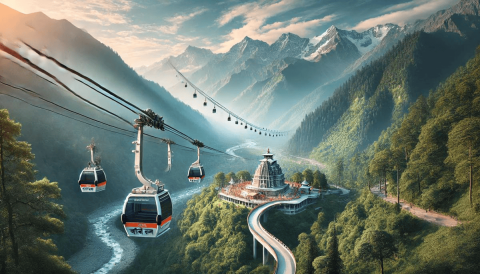Adani Enterprises Emerges as preferred bidder for Sonprayag-Kedarnath Ropeway Project
In a transformative move for India’s religious tourism and mountain infrastructure, Adani Enterprises has emerged as the preferred bidder for the Rs 4,081 crore Sonprayag-Kedarnath Ropeway Project, which promises to redefine access to one of Hinduism’s holiest shrines. This 12.9 km ropeway, set to be among the world’s longest high-altitude cable car systems, will significantly cut travel time and improve safety and sustainability for pilgrims. With cutting-edge 3S gondola technology and a robust public-private partnership model, this project is poised to reshape spiritual tourism and accelerate regional development in Uttarakhand.
Overview of the Sonprayag-Kedarnath Ropeway
The proposed Sonprayag-Kedarnath ropeway is a high-altitude, all-weather aerial transit solution that aims to overhaul the traditional access route to the revered Kedarnath Temple. Located in the Himalayas, the temple currently requires a 16 km uphill trek from Gaurikund, often posing physical challenges and exposure to extreme weather.
Key project features include:
Total Length: 12.9 km
Altitude: Up to 3,583 meters above sea level
Technology: Tri-cable Detachable Gondola (3S) system
Passenger Capacity: 1,800 passengers per hour per direction
Total Annual Capacity: Around 32 lakh pilgrims
Travel Time: Just 36 minutes (compared to 8–9 hours by foot)
Cabin Size: Each gondola can accommodate 36 passengers
This advanced system ensures greater stability and capacity, making it ideal for high-altitude, rugged terrains such as the Himalayas.
Economic Model and Execution
The ropeway will be developed under the Design, Build, Finance, Operate, and Transfer (DBFOT) model via a Public-Private Partnership (PPP) framework. The concessionaire, Adani Enterprises, will:
Invest in construction and equipment
Operate and maintain the ropeway for 35 years
Collect fares from users during this period
Share approximately 42% of revenue with the National Highway Logistics Management Ltd (NHLML)
The government has emphasized that this model ensures both commercial viability and public benefit, without the need for direct upfront public expenditure.
Cabinet Approval and Current Status
The project was officially greenlit by the Cabinet Committee on Economic Affairs (CCEA) in March 2025, marking a crucial milestone. As of April 2025, it has entered the development phase, with financial bids finalized and preparatory groundwork in progress.
The estimated completion timeline is six years, which implies full operations could commence by 2031, assuming adherence to schedule.
Socio-Economic and Environmental Impact
The ropeway project is not merely a transportation upgrade—it’s a comprehensive enabler of socio-economic transformation for the region.
Key benefits include:
Improved Pilgrim Safety: Reduces dependence on treacherous footpaths, ponies, and helicopters
Environmental Gains: Cuts down carbon footprint, animal labor, and fossil fuel usage
Tourism Boost: Facilitates higher footfall, translating to increased earnings for local hospitality, retail, and service sectors
Job Creation: Generates employment during construction and long-term operations in technical, administrative, and service roles
Seasonal Extension: Enables broader access during the Kedarnath temple’s 6–7 month operating window, even during inclement weather
By shifting from foot-based and animal-based transport to low-emission aerial transit, the ropeway offers an eco-conscious alternative, aligning with India’s sustainable development goals in fragile Himalayan ecosystems.
Technical Superiority: Tri-Cable Gondola (3S) System
At the heart of the project lies the Tri-Cable Detachable Gondola (3S) technology, a globally proven system for high-altitude and long-distance ropeways. It provides:
Greater Stability: Operates efficiently in strong wind conditions
Higher Capacity: Each gondola holds 36 passengers with rapid deployment
Efficiency: Ensures consistent service during weather volatility
Durability: Designed for rugged terrains, with minimal maintenance disruptions
This state-of-the-art solution makes it feasible to ferry tens of thousands of pilgrims without compromising safety or comfort.
Comparative Assessment: Trek vs. Ropeway
| Aspect | Traditional Trek | Proposed Ropeway |
|---|---|---|
| Distance | 16 km uphill | 12.9 km aerial |
| Travel Time | 8–9 hours | 36 minutes |
| Accessibility | Physically demanding | All-weather, senior- and child-friendly |
| Environmental Impact | High (animal, fossil fuel usage) | Low (eco-friendly transit) |
| Cost to Pilgrim | High (especially helicopters) | Expected to be affordable |
Strategic Relevance and National Impact
The Sonprayag-Kedarnath project holds broader implications beyond religious tourism. It is a blueprint for future infrastructure projects in ecologically sensitive zones and demonstrates the potential of PPP models in delivering critical infrastructure without fiscal strain on the state.
Furthermore, this project can set a precedent for:
Tech-enabled last-mile connectivity in high-altitude and underserved regions
Private-sector involvement in spiritual tourism, a fast-growing niche in India
Global best practices adoption, with 3S ropeway tech used in the Alps and Rockies now finding home in the Himalayas
Future Outlook: Growth Beyond Kedarnath
Encouraged by the progress on this project, the Govindghat-Ghangaria-Hemkund Sahib Ropeway, estimated at Rs 2,730 crore, is next in line. The project will cater to 11,000 passengers daily and improve access to another revered Himalayan shrine.
These efforts are part of a larger strategy to position India as a global spiritual tourism hub while embracing sustainable infrastructure solutions.
A Visionary Project Bridging Faith, Technology, and Sustainability
The Sonprayag-Kedarnath Ropeway, led by Adani Enterprises, encapsulates a compelling fusion of modern engineering, spiritual access, and environmental consciousness. It’s more than a transport project—it’s a transformation engine for the region and a milestone in India’s infrastructure evolution.
With completion expected by 2031, the initiative is poised to deliver high-impact results across tourism, ecology, and socio-economic indicators. For millions of pilgrims, the arduous trek to Kedarnath will soon give way to a scenic, swift, and sacred ascent—heralding a new era in devotional travel.
